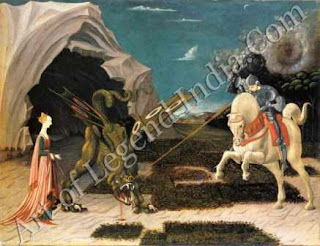 This is
the second of two paintings of St George and the Dragon by Uccello, and there
can have been few more enchanting depictions of the myth. It is painted on
canvas, which was still an unusual material at the time in Italy, and probably
dates from late in the artist's career. Uccello has compressed two incidents
from the story into one scene, for the princess is attached to the dragon by a
sort of dog-leash (in fact, it is her girdle), which alludes to its having been
led docilely by her after St George had defeated it. Uccello's love of pattern
comes out in the dragon's wings, as well as in the formalized depiction of the
landscape and the clouds.
This is
the second of two paintings of St George and the Dragon by Uccello, and there
can have been few more enchanting depictions of the myth. It is painted on
canvas, which was still an unusual material at the time in Italy, and probably
dates from late in the artist's career. Uccello has compressed two incidents
from the story into one scene, for the princess is attached to the dragon by a
sort of dog-leash (in fact, it is her girdle), which alludes to its having been
led docilely by her after St George had defeated it. Uccello's love of pattern
comes out in the dragon's wings, as well as in the formalized depiction of the
landscape and the clouds.Italian Great Artist - Paolo Uccello Painting Gallery
Posted by
Art Of Legend India [dot] Com
On
1:42 AM
Uccello
had a long life, but he was not a I prolific artist and his surviving output is
small. It is also, for the most part, badly documented, so the chronology of
his works ff is uncertain. All his known paintings date from his maturity and
the majority show his preoccupation with perspective. The most spectacular
demonstration of Uccello's interest in the subject comes in his three large
panels representing The Battle of San Romano, in which even one of the corpses
has died in accordance with the rules of perspective. The Hunt at Night shows
Uccello handling a similar array of horses and figures in a more intimate
manner.
Secular
subjects such as these played a remarkably large part in Uccello's work at a
time when religion still dominated the arts. The Flood is Uccello's most
impressive religious painting, the violent perspective recession helping to
create a sense of drama. St George and the Dragon is more lighthearted,
reconciling Uccello's scientific Renaissance outlook with medieval fantasy.
Uccello's
fresco is one of a series of Old Testament subjects by various painters in the
Chiostro Verde (Green Cloister) of Santa Maria Novella. The cloister takes its
name from the fact that the frescoes were painted predominantly in a pigment
called terra verde (green earth). Uccello has shown two stages from the story
of Noah in one scene. On the left, the Ark is afloat and desperate figures try
to cling to it to escape the mass destruction; on the right, the Ark has come
to rest and Noah leans out of a window as the dove returns with the twig
signifying it has found dry land. The heavily draped figure in the foreground
has not been satisfactorily identified.
This
and the two companion panels (pp.1074 and 1076) depicting a Florentine victory
over the Sienese in 1432 were painted for the Medici Palace in Florence, but at
some unknown date they were dispersed and are now in three different galleries.
In this scene, Niccolo da Tolentino, mounted on a white charger, resists the
Sienese attack.
The central figure in
this panel is probably the Sienese commander, Bernardino della Carda, who is
shown being unhorsed. As in the previous scene, the broken weapons in the
foreground recede neatly in perspective, and Uccello has depicted several of
the horses in deliberately difficult poses to show off his skill in foreshortening.
In the
third of his battle panels, Uccello shows Michelotto do Cotignola (on the black
horse) leading the Florentine counter-attack that clinched the victory against
the Sienese. The massed lances give the painting much of its feeling of movement
and together with the fantastic headgear and heraldic trappings, .form
energetic abstract patterns.
 This is
the second of two paintings of St George and the Dragon by Uccello, and there
can have been few more enchanting depictions of the myth. It is painted on
canvas, which was still an unusual material at the time in Italy, and probably
dates from late in the artist's career. Uccello has compressed two incidents
from the story into one scene, for the princess is attached to the dragon by a
sort of dog-leash (in fact, it is her girdle), which alludes to its having been
led docilely by her after St George had defeated it. Uccello's love of pattern
comes out in the dragon's wings, as well as in the formalized depiction of the
landscape and the clouds.
This is
the second of two paintings of St George and the Dragon by Uccello, and there
can have been few more enchanting depictions of the myth. It is painted on
canvas, which was still an unusual material at the time in Italy, and probably
dates from late in the artist's career. Uccello has compressed two incidents
from the story into one scene, for the princess is attached to the dragon by a
sort of dog-leash (in fact, it is her girdle), which alludes to its having been
led docilely by her after St George had defeated it. Uccello's love of pattern
comes out in the dragon's wings, as well as in the formalized depiction of the
landscape and the clouds.
This is
one of Uccello's most original and imaginative paintings. Vasari records that
Uccello 'always loved painting animals' and his delight clearly conies through
in this captivating work. The sleek and highly stylized dogs, in particular,
create a thoroughly convincing impression of darting energy and speed. The
shape of the panel indicates that it may once have been a panel from a cassone
a chest given as a wedding present or in which a bride kept her dowry.
Writer
– Marshall Cavendish
Subscribe to:
Post Comments (Atom)

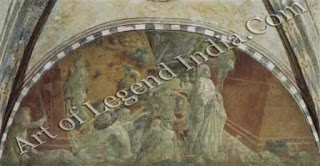

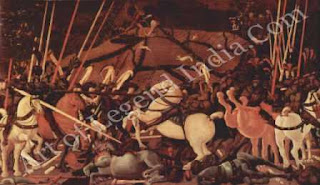
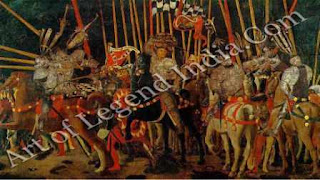
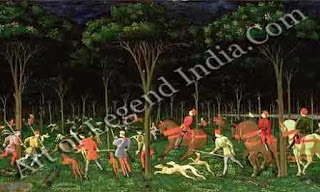










0 Response to "Italian Great Artist - Paolo Uccello Painting Gallery"
Post a Comment